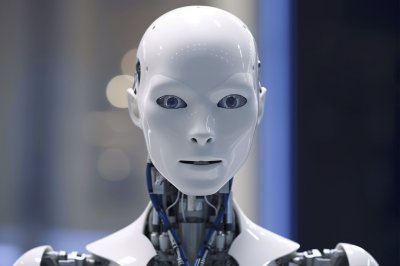Beyond Chatbots: The Rise of AI Humanoids and What It Means for Humanity
By: @devadigax

The age of artificial intelligence is rapidly evolving, moving beyond the realm of text-based chatbots and virtual assistants. A new frontier is emerging: the development and deployment of AI humanoids – robots with human-like appearances and, increasingly, human-like capabilities. This shift represents a significant investment and a potentially transformative leap in AI technology, raising both exciting possibilities and crucial ethical questions.
The reasons behind this surge in humanoid robot development are multifaceted. Firstly, there's the inherent appeal of a physically embodied AI. While chatbots can process information and communicate effectively, a humanoid robot offers a more intuitive and engaging interaction. This is particularly relevant in fields like customer service, healthcare, and education, where human-like interaction can significantly improve user experience and build trust.
Secondly, humanoid robots offer unique advantages in environments designed for humans. Unlike specialized robots designed for specific tasks in controlled environments (like factory assembly lines), humanoids can navigate and adapt to complex, unpredictable human spaces. This opens up opportunities in areas like elder care, where robots can assist with daily tasks, and disaster relief, where they can operate in damaged buildings or hazardous environments.
The technological advancements driving this progress are equally compelling. Advances in robotics, computer vision, natural language processing, and machine learning are converging to create humanoids that are increasingly sophisticated in their movement, perception, and communication. For example, improvements in dexterity allow robots to manipulate objects with greater precision and grace, mimicking human hand-eye coordination. Advances in AI are enabling them to understand and respond to complex human emotions and social cues, leading to more natural and engaging interactions.
However, the rise of AI humanoids also brings about a wave of ethical concerns. The uncanny valley effect – the feeling of unease when a robot looks almost, but not quite, human – remains a significant challenge. Designing robots that appear both human-like enough to be effective yet not unsettling requires careful consideration of their physical design and behavior.
Furthermore, questions around job displacement, data privacy, and the potential for misuse of this technology demand careful attention. As humanoids become more capable, they could potentially replace human workers in various industries, necessitating proactive measures to mitigate the negative impacts on employment. Ensuring the responsible use of data collected by these robots, including protecting user privacy and preventing bias in algorithms, is paramount. And, perhaps most importantly, society needs to engage in a thoughtful dialogue about the societal implications of increasingly advanced and autonomous machines.
One of the key areas of focus for researchers and developers is ensuring that AI humanoids operate safely and reliably. This involves rigorous testing and the development of robust safety mechanisms to prevent accidents and unintended consequences. Moreover, the integration of ethical guidelines and regulations into the design and deployment of these robots is crucial to avoid potential misuse.
The development of AI humanoids is not just a technological advancement; it's a societal transformation in the making. While the future remains uncertain, it's clear that these sophisticated machines will play an increasingly significant role in our lives. By carefully considering the ethical implications and proactively addressing potential challenges, we can harness the transformative potential of AI humanoids while mitigating the risks. The journey beyond chatbots has begun, and the path ahead will require careful navigation and thoughtful consideration of both opportunity and responsibility.
The reasons behind this surge in humanoid robot development are multifaceted. Firstly, there's the inherent appeal of a physically embodied AI. While chatbots can process information and communicate effectively, a humanoid robot offers a more intuitive and engaging interaction. This is particularly relevant in fields like customer service, healthcare, and education, where human-like interaction can significantly improve user experience and build trust.
Secondly, humanoid robots offer unique advantages in environments designed for humans. Unlike specialized robots designed for specific tasks in controlled environments (like factory assembly lines), humanoids can navigate and adapt to complex, unpredictable human spaces. This opens up opportunities in areas like elder care, where robots can assist with daily tasks, and disaster relief, where they can operate in damaged buildings or hazardous environments.
The technological advancements driving this progress are equally compelling. Advances in robotics, computer vision, natural language processing, and machine learning are converging to create humanoids that are increasingly sophisticated in their movement, perception, and communication. For example, improvements in dexterity allow robots to manipulate objects with greater precision and grace, mimicking human hand-eye coordination. Advances in AI are enabling them to understand and respond to complex human emotions and social cues, leading to more natural and engaging interactions.
However, the rise of AI humanoids also brings about a wave of ethical concerns. The uncanny valley effect – the feeling of unease when a robot looks almost, but not quite, human – remains a significant challenge. Designing robots that appear both human-like enough to be effective yet not unsettling requires careful consideration of their physical design and behavior.
Furthermore, questions around job displacement, data privacy, and the potential for misuse of this technology demand careful attention. As humanoids become more capable, they could potentially replace human workers in various industries, necessitating proactive measures to mitigate the negative impacts on employment. Ensuring the responsible use of data collected by these robots, including protecting user privacy and preventing bias in algorithms, is paramount. And, perhaps most importantly, society needs to engage in a thoughtful dialogue about the societal implications of increasingly advanced and autonomous machines.
One of the key areas of focus for researchers and developers is ensuring that AI humanoids operate safely and reliably. This involves rigorous testing and the development of robust safety mechanisms to prevent accidents and unintended consequences. Moreover, the integration of ethical guidelines and regulations into the design and deployment of these robots is crucial to avoid potential misuse.
The development of AI humanoids is not just a technological advancement; it's a societal transformation in the making. While the future remains uncertain, it's clear that these sophisticated machines will play an increasingly significant role in our lives. By carefully considering the ethical implications and proactively addressing potential challenges, we can harness the transformative potential of AI humanoids while mitigating the risks. The journey beyond chatbots has begun, and the path ahead will require careful navigation and thoughtful consideration of both opportunity and responsibility.
Comments
Related News

OpenAI Unveils ChatGPT Atlas: Your Browser Just Became Your Smartest AI Assistant
In a move poised to fundamentally reshape how we interact with the internet, OpenAI has officially launched ChatGPT Atlas, a gr...
@devadigax | 22 Oct 2025
In a move poised to fundamentally reshape how we interact with the internet, OpenAI has officially launched ChatGPT Atlas, a gr...
@devadigax | 22 Oct 2025

Netflix Doubles Down on Generative AI, Challenging Hollywood's Divide Over Creative Futures
In a move that underscores a growing chasm within the entertainment industry, streaming giant Netflix is reportedly going "all ...
@devadigax | 21 Oct 2025
In a move that underscores a growing chasm within the entertainment industry, streaming giant Netflix is reportedly going "all ...
@devadigax | 21 Oct 2025

AI Agent Pioneer LangChain Achieves Unicorn Status with $1.25 Billion Valuation
LangChain, the innovative open-source framework at the forefront of building AI agents, has officially joined the exclusive clu...
@devadigax | 21 Oct 2025
LangChain, the innovative open-source framework at the forefront of building AI agents, has officially joined the exclusive clu...
@devadigax | 21 Oct 2025

Meta Boots ChatGPT From WhatsApp: A Strategic Play for AI Dominance and Walled Gardens
In a significant move that reshapes the landscape of AI chatbot accessibility, OpenAI has officially confirmed that its popular...
@devadigax | 21 Oct 2025
In a significant move that reshapes the landscape of AI chatbot accessibility, OpenAI has officially confirmed that its popular...
@devadigax | 21 Oct 2025

Meta's New AI Peeks Into Your Camera Roll: The 'Shareworthy' Feature Raises Privacy Eyebrows
Meta, the parent company of Facebook, has rolled out a new, somewhat controversial artificial intelligence feature to its users...
@devadigax | 18 Oct 2025
Meta, the parent company of Facebook, has rolled out a new, somewhat controversial artificial intelligence feature to its users...
@devadigax | 18 Oct 2025
 AI Tool Buzz
AI Tool Buzz